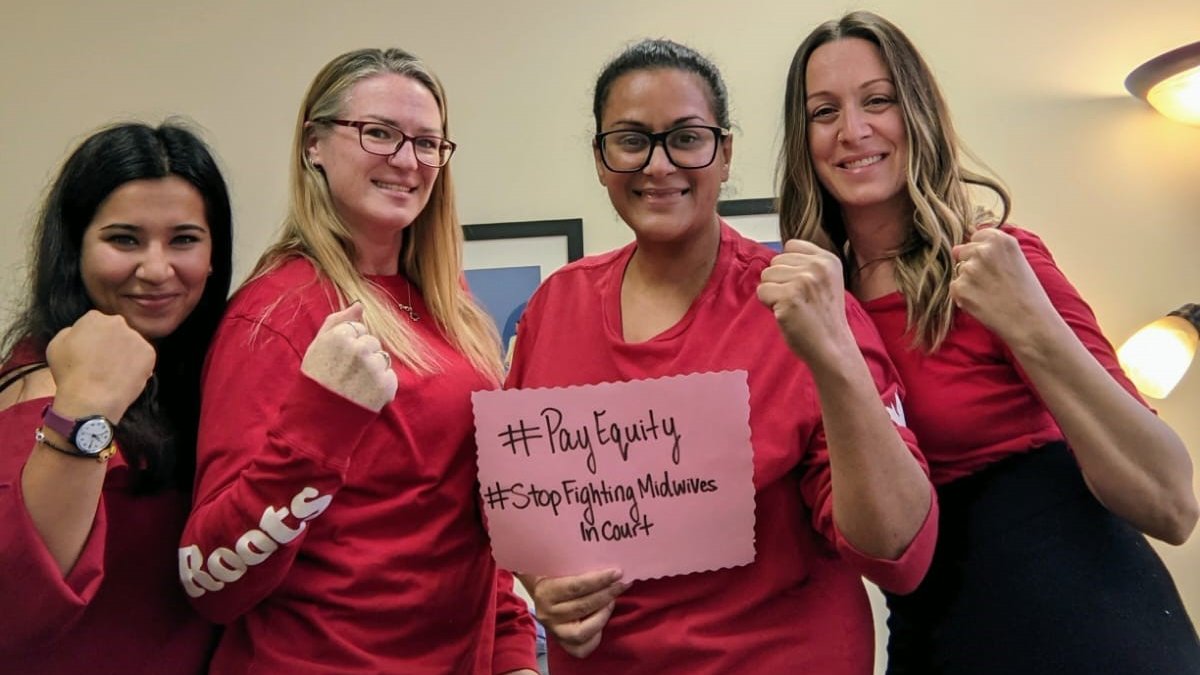Midwives defend gender-based rights against government at the Ontario Court of Appeal

November 19, 2021
On November 10, 2021, the AOM’s legal team defended the decisions of the Human Rights Tribunal of Ontario (HRTO) and the Divisional Court of Ontario, which found government was responsible for gender-based discrimination in its compensation of midwives.
The hearing was heard by a panel which included Associate Chief Justice Michal Fairburn, Justice Louis Roberts and Justice Francine Van Melle.
This overview provides a summary of the arguments of government and AOM, submissions, and next steps in the case.
Ministry of Health
The Ministry of Health’s legal team, represented by Zachary Green and Yashoda Ranganathan, argued that:
- there are occupational differences between midwives and CHC physicians, arguing the Tribunal largely ignored and minimized the differences between midwives and CHC physicians. The Ministry minimized midwifery scope of practice;
- midwives and CHC physicians are both female-predominant groups. This argument is used to discredit CHC physicians as a “male comparator” as determined by the Tribunal. The argument ignores that: physicians are overall historically a male-predominant group and comparator; as a group, physicians still receive the advantages and benefits of being associated with male work; CHC physician pay is aligned with other physicians who continue to be male-predominant;
- changes to CHC salaries were driven by issues of recruitment/retention, and as such differences between CHC physicians and midwives' pay were not attributable to sex/gender;
- there were no recruitment/retention problems for midwives, claiming that increasing the compensation of midwives would not influence the number of midwives providing service;
- the history of compensation for midwives, including the 1993 Morton Report, which set the compensation of midwives at the time of regulation, did not involve a pay equity exercise, as the historical documents do not refer to “pay equity”, "sex", "gender", or "male comparators", and the lead compensation consultant at the time, Robert Morton, did not have pay equity expertise;
- the 2010 Courtyard report (funded by Ministry) did not conduct a pay equity review, and did not refer to sex, gender or discrimination. Ministry argued that the report was flawed. Therefore, Courtyard's recommendation for a 20% equitable adjustment was not indicative of a pay equity gap related to gender.
Government further made legal arguments, including that the HRTO:
- failed to provide a rational chain of analysis and ignored important evidence;
- lacked proof that sex was a factor; the fact that midwives are predominantly female and closely associated with women is not proof that sex was a reason for adverse treatment;
- wrongly imposed an obligation on Ontario to compare midwives’ compensation to that of CHC physicians;
- ordered unreasonable remedies.
Association of Ontario Midwives
AOM legal counsel, led by Mary Cornish and Adrienne Telford, and including Jackie Esmonde and Lara Koerner-Yeo, responded to the Ministry’s facts and legal arguments:
- The HRTO is the expert in human rights and systemic sex discrimination, according to its specialized expertise and the legislated standard
- The HRTO decision is “transparent, intelligible, and justified”, and the Supreme Court of Canada cautions courts to “tread lightly” when it comes to issues that are in the Tribunal’s domain
We need to give deference to the Tribunal's analysis. This is not a line-by-line treasure hunt for errors; we need to look at all of the factual findings the Tribunal relied on to establish that it was more likely than not that sex was a factor in discrimination.
– Adrienne Telford, AOM legal counsel
- Discrimination is made up of “an amalgam of events” – omissions, pattern, conduct, and policies of the Ministry towards the most highly sex/gender-segregated profession in the province
- The onus of proof was not reversed; midwives successfully established a prima facie case of sex discrimination by making a simple connection between adverse treatment and sex/gender, separate from the Ministry’s intent (or lack thereof)
- Ministry’s explanations do not disprove systemic gender discrimination, which is often subtle, hidden, and requires a comprehensive and sophisticated analysis of effects, rather than fishing for particular words like ‘gender’, ‘sex’ or ‘pay equity’
- Under the Code, the Ministry has a legal duty to proactively ensure substantive equality, regardless of whether a human rights complaint is brought forward or not. The Tribunal found the Ministry liable, when it itself admitted it had taken “no proactive steps” to monitor the compensation of midwives for the well-known effects of systemic gender discrimination in compensation.
In 1993, the parties recognized the problem – system gender discrimination – and the solution – the mechanism for identifying and redressing systemic gender discrimination in midwives' compensation: the parties' benchmarks. By 2010 the Ministry had unilaterally abandoned the benchmarks – the mechanism for ensuring midwives' compensation remained free of discrimination. This mechanism is central to the Tribunal’s findings”
– Adrienne Telford, AOM legal counsel
- The Tribunal had a reasoned analysis for its remedies, including prospective and retroactive elements
HRTO
The Tribunal made submissions emphasizing the importance of giving deference to the Tribunal's decision-making.
Intervention by the Ontario Human Rights Commission
The Ontario Court of Appeal allowed the Ontario Human Rights Commission (OHRC) to make written and oral submissions. The OHRC underscored the significance and implications of overturning the Tribunal decision case for future human rights cases.
Next Steps
Midwives now await the decision from the OCA hearing, which could take several months.
